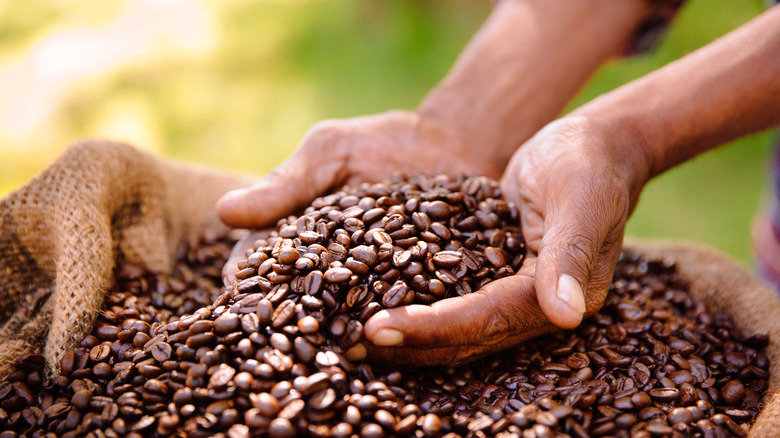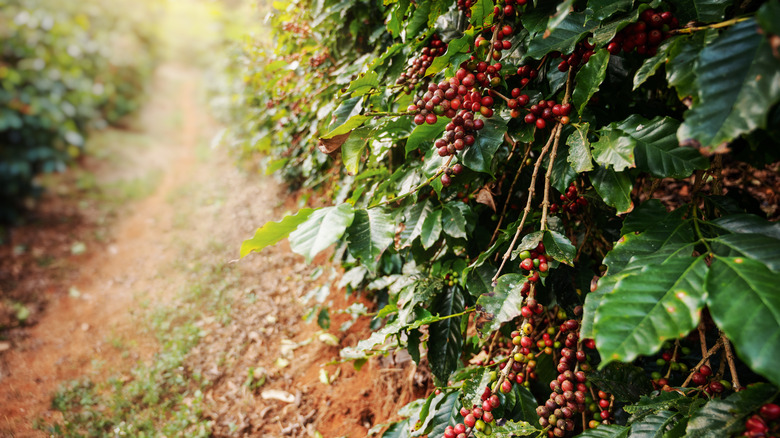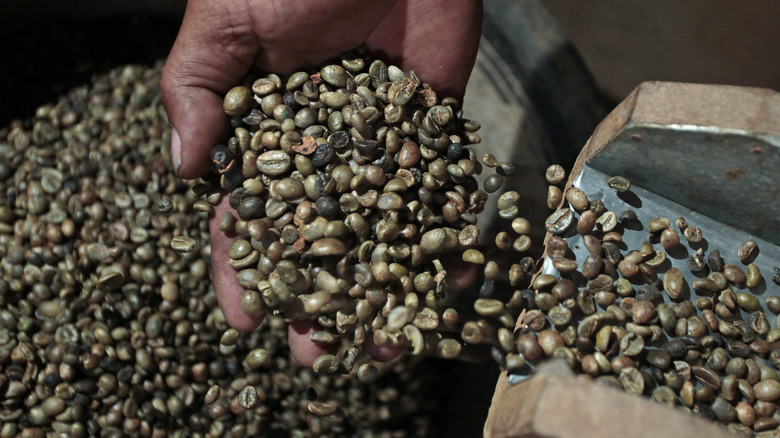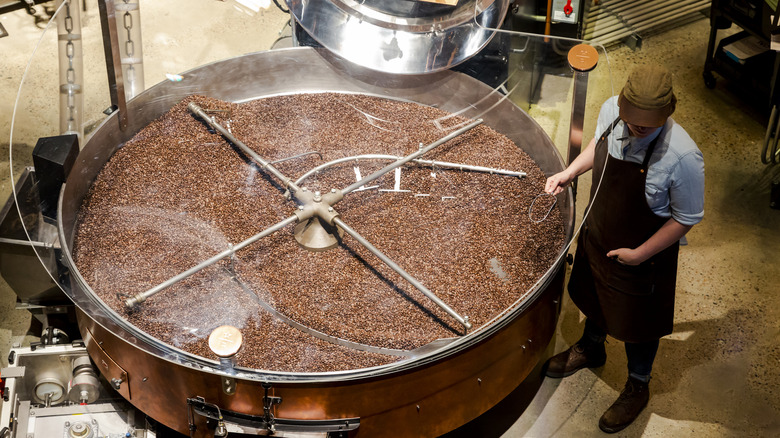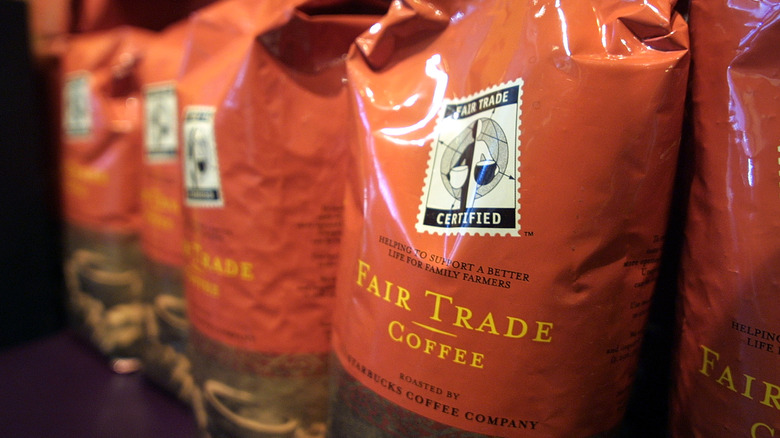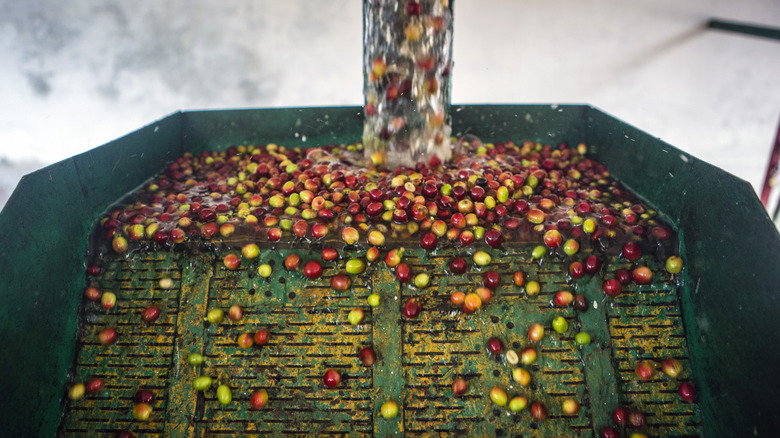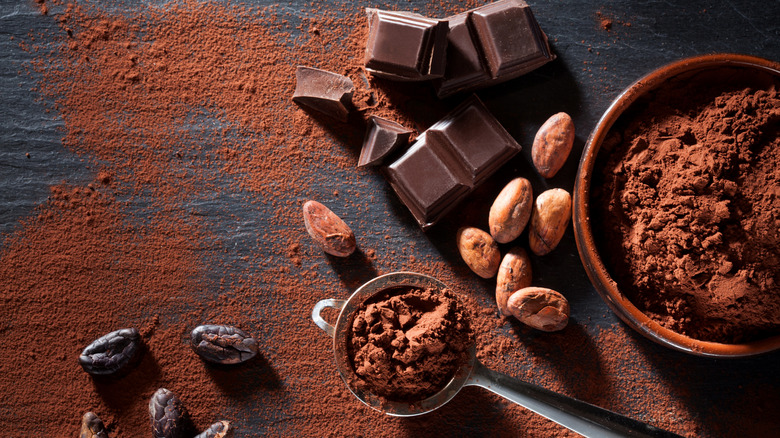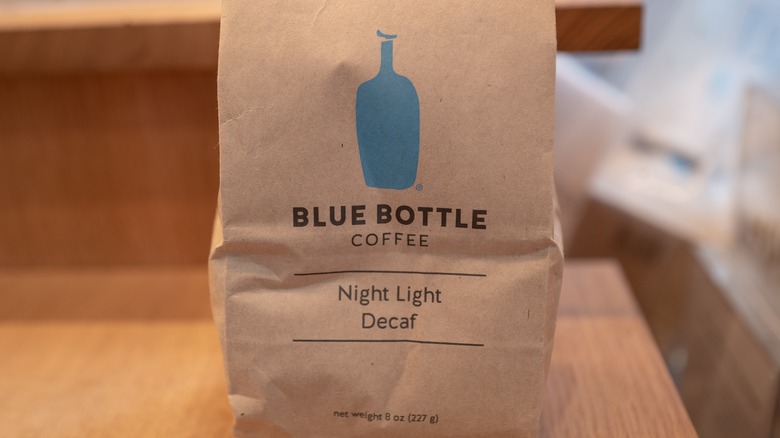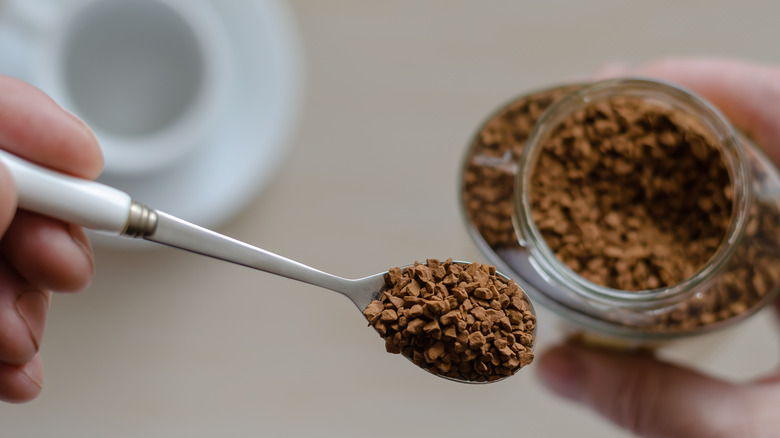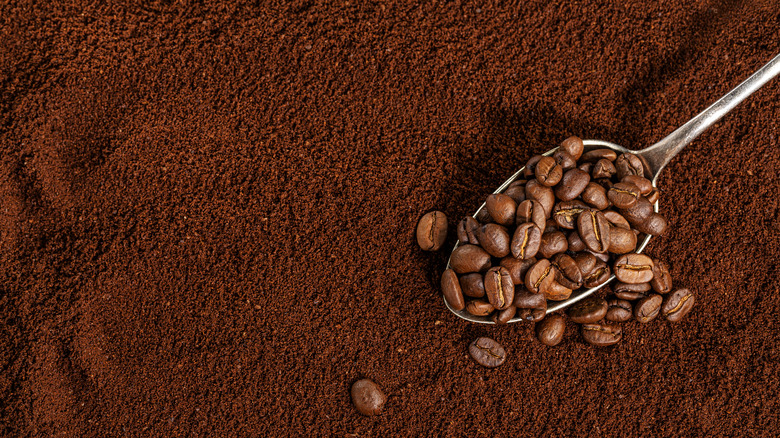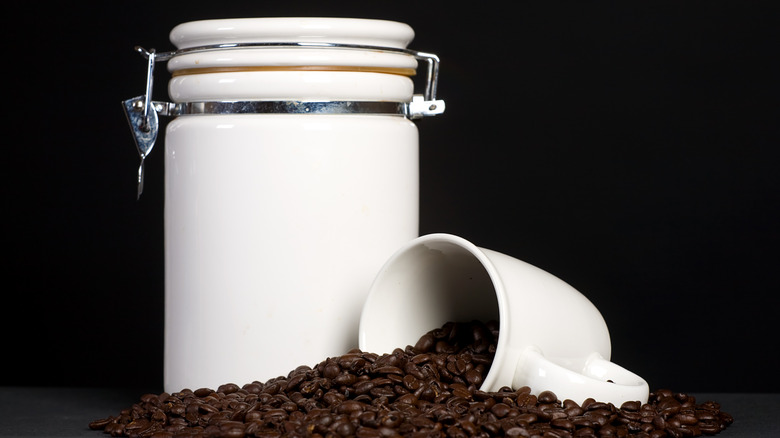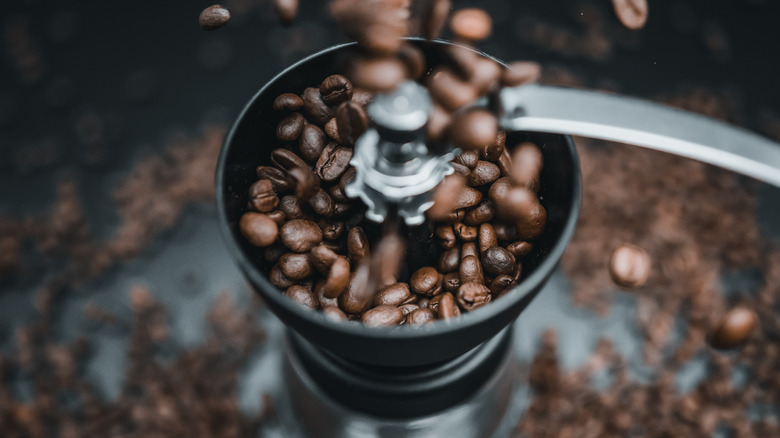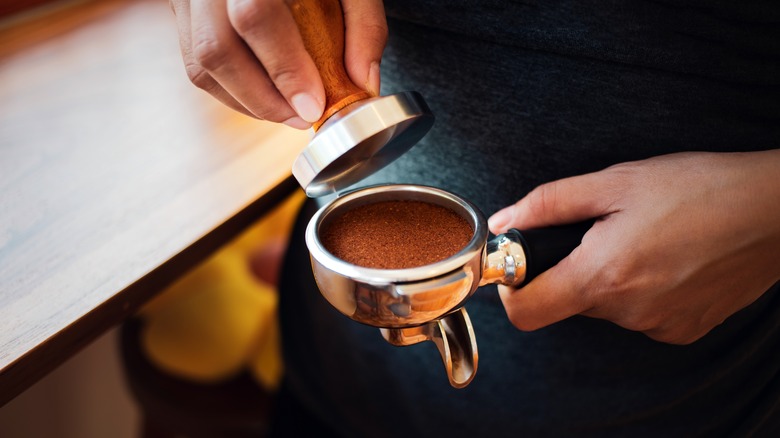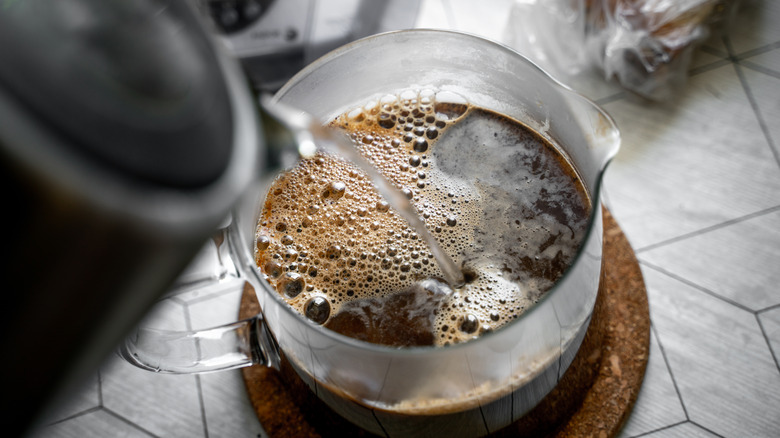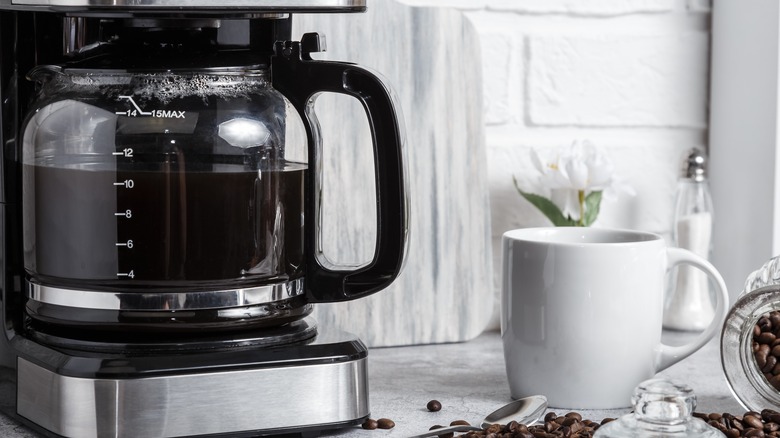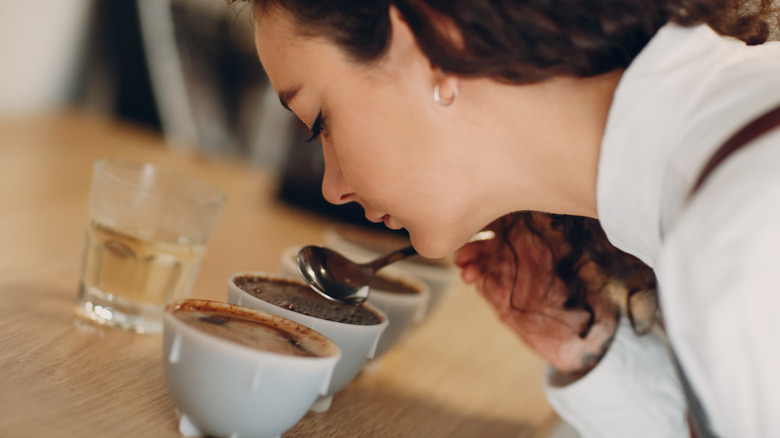A Beginner's Guide To The Wide World Of Coffee Beans
Coffee production and consumption are big businesses globally. According to World Population Review, while oil is the number one export on the planet, coffee beans rank a close second, with Brazil, Vietnam, and Colombia being the top producers of this commodity. The origins of coffee beans purportedly go back to Ethiopia, where a goat herder named Kaldi stumbled upon the magical capabilities of the Coffea plant by accident after witnessing his goats getting stimulated from eating the coffee berries.
By the 16th century, coffee was cultivated and traded across the Arabian Peninsula, particularly in Turkey, Persia, and Syria. Coffee made its way to Europe by the 17th century. It was initially seen as demonic until Pope Clement VIII gave it his blessing, allowing coffee consumption to spread across the continent. Coffee arrived in the U.S. in the 1600s but would not gain traction as the beverage of choice until the infamous Boston Tea Party in 1773.
Today, the U.S. remains the top coffee consumer globally, although per capita coffee consumption is highest in Scandinavian countries. Average Americans drink approximately three cups of coffee daily for its flavor and pick-me-up properties.
Drinking coffee in moderation has been associated with myriad health benefits, including lowering the risk of type 2 diabetes, supporting brain health, preventing liver disease, and promoting heart health, according to Healthline. That said, a good cup of coffee starts with the beans — how to source, roast, store, brew, and drink them. Let's look at the basics of how to get the best cup of Joe from the ground up.
What is the coffee belt?
The area known as the coffee belt is a 3,200-mile stretch around the globe that spans five continents, North America, South America, Oceania, Africa, and Asia, about 70 countries, of which only 44 grow the majority of coffee. They cover areas 23.5 degrees north and south of the Equator between the Tropics of Cancer and Capricorn. This region is ideally suited to the growth of the coffee bean, making it the area where most coffee beans come from.
The key to the coffee belt is its geography, which though different from country to country and farm to farm, does have characteristics necessary for the coffee bean to thrive. First, coffee requires optimal rainfall, with a balance of wet and dry periods during which the beans can get fertilized and harvested. Second, coffee is delicate, favoring temperatures between 59 degrees Fahrenheit to 86 degrees Fahrenheit to grow.
Additionally, coffee tends to prefer shade, which not only slows its growth, encouraging more nuanced flavors thanks to the slower development of the inherent sugars in the bean, but it stunts weed growth, encourages pollination, keeps pests at bay, and helps to deter frost.
Altitude is also critical to coffee growth. Coffee grown between 3,300 to 6,600 feet above sea level develops ideal caffeine and acidity levels. And finally, coffee requires porous soil, allowing for drainage and storage of water. It should also contain abundant levels of nitrogen and acidity, which are features of volcanic and sandy soils. These factors are at risk due to climate change.
What is the difference between Arabica and Robusta beans?
Almost all of the world's coffee supply is two coffee species, Coffea arabica, and Coffea canephora, typically referred to as arabica and robusta. About 60% of the world's coffee supply is of arabica, while around 40% is the robusta variety.
Arabica coffee gets prized for its milder, more nuanced flavor. It is lower in caffeine and higher in sugar than robusta. Robusta beans tend to be bitter, with notes of rubber, malt, and a peanut-forward lingering taste, making it an acquired coffee flavor. It commonly gets added as a filler to instant coffee and espresso blends.
That said, robusta beans are easier to grow than arabica beans. Robusta beans are far more tolerant of harsh temperatures. Its higher caffeine levels make it highly pest and disease resistant, allowing it to grow at almost any altitude, even at sea level. It is a fast-growing plant, reaching maturity within 2 years versus 4 years for arabica beans. It also produces more cherries, making it more economical.
The robusta breed is younger than its arabica cousin and has more inconsistently shaped and colored beans. It is genetically less complex, containing only 22 versus 44 chromosomes. Its advantage in today's market is its ability to withstand the environmental adaptations currently underway due to climate change. As the regions that have historically been ideal for coffee production begin to contract, introducing the robusta bean to our daily coffee consumption may become necessary to meet the global demand for coffee.
Why the way you roast coffee beans matters
While there are some basics to roasting coffee beans, coffee connoisseurs point out that two factors are necessary to master the art of roasting coffee: Knowing where your beans come from and understanding how its distinct terroir will influence the beans grown there. Coffee beans begin as little spongy green nuggets. Roasting beans helps dry them and coax their natural oils out of them, accentuating flavor and shelf-life.
Beans can be roasted light, medium, medium-dark, and dark. Contrary to popular belief, lighter roasts often have higher caffeine content than darker roasts. And darker roasts can be more bitter in flavor, depending upon the bean's origin. Additionally, the darker the roast, the more oily the beans appear. Speed of roasting also matters, with slower roasting being easier to control, providing a more consistent flavor profile.
Determining the proper roast for a given crop of beans begins with the altitude at which the bean grew. Generally, beans grown at higher altitudes take longer to mature, yielding sweeter harder beans. Softer beans require more care with roasting, including lower temperatures and longer roasting times. Harder beans can get roasted at higher temperatures and faster speeds.
Inherent flavors can change roasting habits as well. High-altitude acidic beans tend to have more fruit-forward flavors, while lower-altitude beans with lower acidity require slower roasting to develop their sweetness. In many ways, a coffee roaster is like a winemaker. Each must use their knowledge and refined palate to determine the best roast for a bean.
What exactly does fair trade mean?
Fair trade coffee is a concept that grew out of a legitimate desire to accomplish four distinct goals, including creating safe working conditions for farmers and their employees, protecting the environment, bolstering the livelihoods of those involved in food production, and funding community development in underdeveloped countries.
These admirable objectives got designed to promote consumer awareness and increase the viability of food systems and the communities from which they originate. That said, some concerns about the program exist, primarily with expanding it to include larger producers already squeezing smaller plantations out of the equation — the very farmers that fair trade was designed to protect.
Like organic food certification, fair trade certification can cost money. Certification may cost a grower up to $0.03 per pound of coffee, squeezing growers from more impoverished nations out of the opportunity to participate, according to the Huffington Post. These countries, including Ethiopia, Kenya, and Tanzania, make up less than 10% of all coffee certified as fair trade. It gives consumers a potentially false sense of security that by purchasing strictly fair trade, they are solving global poverty and environmental destruction.
The solution is much the same as with other crops, ask questions about the individual farms from which the products get sourced. Certification aside, some smaller producers may use sustainable growing practices and pay their employees living wages but cannot afford to participate in the certification process. These farms are equally deserving of business as those with the means to get certified.
What is the difference between dry processing and wet processing?
Harvested coffee cherries surround the beans with pulp, sugar, and papery skin. Obtaining the coffee bean requires processing. There are two types of processing — dry and wet. Dry processing is also known as natural processing — this process involves allowing the coffee cherry to dry without any preparation.
It is the most basic, easy means of obtaining the coffee bean and the most unpredictable. Because coffee cherries may be different sizes and more or less ripe when harvested, they may dry at different speeds, necessitating constant rotating and monitoring of the beans to prevent rotting. This process also may yield a distinctive sweet flavor that masks the inherent properties of the beans.
Wet processing, or washed processing, involves extracting the coffee bean from the fruit, eliminating all the pulp and skin through a highly machinated process, after which the beans get dried. This process is more invasive, but it yields what many perceive to be a higher quality bean, exhibiting the purest expression of its flavor. Again, this may be a matter of taste, but since you often don't get the opportunity to sample the same bean processed in both dry and wet methods, if you are drinking a single-origin bean, you may want to obtain a bean that has been wet-processed.
A rare hybrid method called honey processing only partially removes the fruit, leaving more or less of the cherry attached to the bean. This encourages some sugar to remain while allowing the bean to express its full flavor.
What exactly is flavored coffee?
Flavored coffees are all the rage. If you go into any specialty grocery store or coffee shop that sells coffee beans, you'll find flavors like vanilla, chocolate, snickerdoodle, hazelnut, and more. These aren't particularly sweet, but they enhance the coffee bean with a mild flavor that many consumers love. Flavorings get added to coffee in three ways.
First, natural seasonings, like cinnamon, vanilla, nuts, cocoa beans, anise, cloves, nutmeg, or peppercorns, may be placed into the roaster along with the beans, infusing them with these flavors. This method of imparting flavorings into beans doesn't noticeably influence their taste, aroma, or look.
The second way of imparting flavor to coffee beans is to use natural food extracts, similar to vanilla or almond extracts used in baking, that dissolve into water or vegetable-based solvents before application to the beans. These natural extracts impart intense aromas, are mellow in taste, and make the beans look slightly glossy.
The final method for imparting flavor to coffee beans is through chemical flavorings curated by chemists using up to 80 different ingredients. These get mixed with a solvent known as propylene glycol, which in large quantities may be toxic but is safe in moderation unless you have a food allergy or are on an anti-inflammatory diet.
These beans have an overwhelming aroma, an artificially sweet taste, and a greasy-looking coating that can leave residue on your coffee maker. Flavored coffees occasionally utilize older beans past their prime, so buyers beware.
How are coffee beans made decaffeinated?
Some people enjoy the flavor of coffee but cannot tolerate caffeine, so they drink decaf coffee. Decaffeinated coffee contains no more than 3% caffeine in it. Contrary to its name, 100% decaffeinated coffee doesn't exist. There are four methods for removing caffeine from coffee beans: Direct solvent, indirect solvent, supercritical carbon dioxide process, and Swiss water process.
All get completed before roasting the beans. The primary solvents utilized in decaffeination are methylene chloride or ethyl acetate. These are FDA-approved, and no more than one part per million of the solvent remains after processing. The direct solvent method begins with soaking the beans in water before introducing the solvent, which will remain on the beans for ten hours before the beans get steamed to eliminate residual solvent.
The indirect solvent process, which is the most common, starts by boiling the beans in water, which removes the caffeine and water-soluble compounds. Once the beans get strained from the liquid, it gets infused with solvent, neutralizing the caffeine. The beans get added back to the liquid to reabsorb any lost nutrients.
The supercritical carbon process involves circulating the soaked beans through a device exerting 73 to 300 atmospheres of supercritical carbon dioxide upon the beans for ten to twelve hours.
The Swiss water method is the least invasive, using water and green coffee extract to soak the beans, which then get filtered through activated charcoal to remove the caffeine. No matter which method gets used, the flavor will not be the same as caffeinated beans.
What is instant coffee?
Because of its convenience and affordability, instant coffee often represents up to 50% of the coffee consumed in many countries. That's rather substantial. Instant coffee is typically lower in caffeine than regular coffee, with instant coffee having 30 to 90 milligrams per teaspoon and regular coffee containing 70 to 140 milligrams per cup. Instant coffee may also contain higher levels of the potentially harmful chemical acrylamide, which may adversely impact the central nervous system and be a carcinogen in high quantities, according to Healthline.
The earliest iteration of soluble instant coffee appeared in 1899 in New Zealand. Today, instant coffee gets made in two ways: Freeze-drying and spray-drying. Spray-drying involves dehydrating liquid coffee by blowing it about at air speeds of around 400 miles per hour with hot air at approximately 1000 degrees Fahrenheit. The resulting powder is less flavorful and experiences a marked loss of smell, making it a less desirable product even if it is far cheaper to produce than freeze-dried instant coffee. For this reason, it is a less common method than freeze-drying.
Freeze-drying involves evaporating brewed coffee into an extract that gets frozen before becoming pulverized into granules. These granules get sublimated or turned into a gas without moving through a liquid state. This process dehydrates the granules while maintaining the natural aromas of the coffee. The freeze-dried coffee is subsequently packaged and ready for distribution. Instant coffee requires only boiling water to rehydrate the beans for a satisfying cup of Joe.
Why should you avoid pre-ground coffee?
Because coffee is such a hot commodity, it is also highly susceptible to fraud. According to an article published in Foods, titled "HPLC-Based Chemometric Analysis for Coffee Adulteration," coffee is among the ten most contaminated food products on the planet. Ground coffee can get laced with fillers, like chicory, brown sugar, wheat, soybeans, acai berries, corn, barley, and peanuts, which sneak into the ground coffee without detection.
These are concerning enough adulterants, but coffee can also get laced with items that get mixed in during the harvesting and processing phases of the bean, such as wood, twigs, sticks, parchment, husks, whole coffee berries, and soil, which remain invisible because they blend into the coffee grinds.
This phenomenon is occurring because it helps reduce the cost of production. It is also occurring due to widespread issues associated with climate change, including drought and diseases, such as leaf rust, impacting the worldwide coffee supply. It is particularly concerning for countries like Brazil, the largest coffee supplier in the world, relying heavily on its export for its GDP. It is also of concern for consumers, not only from a quality perspective but for those who may suffer from food allergies.
Researchers have developed a testing regiment called high-performance liquid chromatography that can accurately identify contaminants in coffee, but this method is costly and time-consuming. Until more effective detection methods or better quality control measures get implemented in global coffee production, the best way for consumers to avoid this adulterated coffee is to purchase whole beans.
What is the best way to store coffee beans?
Good quality coffee beans are not cheap. But buying in bulk poses the problem of the rapidity with which coffee loses its flavor and aroma. Coffee requires a few days after being roasted to sit, allowing any residual carbon dioxide to get released for maximum shelf-life. After that point, coffee in its original bag begins to deteriorate after just one week. For this reason, it is critical that you transfer your precious beans into airtight containers, preferably vacuum-sealed containers, and store these in a cool, dry place away from sunlight.
Air, light, and moisture are coffee's greatest enemies. They can promote cellular degradation of the beans, influencing the aroma and making the beans stale. For this reason, the old wives' tale that you should always freeze or refrigerate your coffee is wrong. Coffee is hygroscopic, meaning it readily finds any moisture and sucks it up, displacing the essential oils which give coffee its flavor and adopting any foul odors that may be piggybacking off that moisture, which gets exacerbated whenever you take coffee in and out of the freezer or refrigerator.
If you intend to purchase coffee in bulk, you can freeze it once. Place it in an airtight container and store it in the back of the freezer, where it will be less susceptible to temperature fluctuations. Never freeze coffee for longer than one month. These beans should get thawed before use and consumed within two weeks of thawing for the best quality coffee.
What is the best way to grind coffee beans?
For the best quality cup of coffee, we always recommend grinding your beans immediately before brewing them. Coffee loses about 60% of its aroma within 15 minutes after grinding it. Other important factors include the type of grind and how coarse or fine you grind your beans. The flavor of coffee gets obtained from how long the water remains in contact with the ground coffee beans, which is called extraction.
The longer the beans mingle with the water during brewing, the coarser the coffee grinds can be. If you grind your beans too finely, they may taste bitter. If your coffee tastes acidic or watery, you haven't ground them finely enough. Cold brews and French press require slightly coarser grinds, while espresso and Turkish coffee require finer grounds. Drip coffee lands in the middle.
The second factor affecting ground-up beans is the type of coffee grinder you use — a blade grinder or burr grinder. Blade grinders look a lot like airplane propellers. While these grinders are affordable and readily available, they grind beans inconsistently, leaving larger chunks interspersed with finer grinds, making an uneven cup of coffee. Additionally, friction from the spinning blades produces heat, which can adversely affect the cellular structure of the beans.
Burr grinders use a crushing mechanism of two discs, known as burrs. They tend to grind beans evenly and can be programmed to grind to specific sizes for different brews, but they are pricey. Whichever you choose, consistency of the ground is the key.
Why do you tamp coffee beans?
At high-end coffee shops where an actual barista still makes espresso drinks using an old-fashioned machine, you will witness the fascinating dance known as tamping. Tamping is a process by which a barista measures a precise amount of espresso grounds into a device known as a portafilter. The barista will then either level the grounds by hand or a leveler or tap the portafilter horizontally and vertically to settle them. From this point, they will use a flat contraption known as a tamper to press it into the portafilter before attaching it to the espresso machine for brewing.
Tamping ensures that flavor gets extracted from the espresso beans. Under tamping will leave little air pockets known as channels through which the pressurized water will squeeze without spending time in contact with the espresso grounds, yielding a watered-down, flavorless shot. Over-tamping won't allow the water into the beans, creating an unsatisfactory pull.
The ideal tamping should be level, apply even pressure, anywhere from 15 to 30 pounds, and should only get done once. Understanding the precise amount of pressure to apply can involve trial and error, although the best baristas recommend tamping until the beans no longer yield to the tamper. The bottom line — tamping is simultaneously a science and a bit of a sport. It requires skill, technique, and some strength to achieve the perfect viscous yet oily pull of espresso that'll make or break your latte, cappuccino, or macchiato.
Why does the water you use matter when you brew coffee?
There is some debate about what type of water to use for the perfect brew. Since water makes up about 99% of the cup of coffee you are drinking, the kind of water you use – tap versus filtered — is of utmost importance. Three factors should get considered where water is concerned: temperature, acidity, and mineral content. The perfect water temperature for extracting flavor when brewing coffee ranges from 195 degrees Fahrenheit to 205 degrees Fahrenheit. Where acidity is concerned, the margin of perfection lies within a tight window of a pH between six and seven.
Where mineral content is concerned, things get a bit more complicated. There are two camps of thought. In the filtered water camp are those who prefer their coffee to be uniform in flavor every time they brew a cup, which may yield a slightly mellower flavored coffee, but provides a bit of insurance that the minerals in your tap water aren't creating a bitter cup of coffee.
In the tap water camp are those who recognize that certain minerals, like magnesium and calcium, can adhere to the coffee grounds, extracting more flavor from them, giving your coffee more complexity, potent flavor, and potentially higher caffeine content.
The problem is that it is hard to know what minerals are in your tap water, which makes using tap water a bit of a crap shoot. To ensure consistency in your coffee, we recommend investing in a filtration system to guarantee your coffee tastes the same every time.
What is the best way to brew fresh coffee beans?
Once you have obtained the best beans, determined the best roast, ground your coffee to perfection, and got a water filter, you are ready to brew your coffee. The type of brew method you choose may have more to do with individual preference than anything scientific, but here are a few basics to help you choose the best one for you. There are pressure-based methods where water gets pushed through the coffee grinds to extract their flavor, which includes espresso, Moka coffee pot, vacuum brewers, and the AeroPress. These brewing methods produce strong cups of coffee with complex flavors.
Gravity brewing methods include drip coffee, percolators, and pour over coffee brewers. As the name implies, heated water gets introduced to the coffee grounds and then slowly extracted through a drip process. The resulting coffee is consistent, flavorful, and suited to all different types of coffee beans. Finally, the steeping or immersion brewing methods include French press, Turkish coffee, and cold brew. These encourage the coffee grinds to soak in hot or cold water for an extended period to extract their flavor. The result can be coffee that has held onto its essential oils and may be less acidic.
In many cases, the brewing method may be most influenced by how often and how much coffee you drink at a time, how much time you have to invest in brewing your coffee, and how much you want to spend on your brewing equipment. A good cup of coffee doesn't have to be cost-prohibitive or overly time-consuming.
What is the best way to taste coffee?
While this may not surprise some, coffee is as nuanced in flavor as wine, incorporating flavors from the terroir where it grows, which can impact every aspect of a bean. Because of this, learning how to taste coffee, known as cupping to professional tasters, not unlike sommeliers of the wine world, is crucial. Coffee gets tested for five elements, including cleanness, sweetness, acidity, mouthfeel, and aftertaste.
The best beans will have balanced aspects of each, redolent of the farm from which it got harvested. To properly cup coffee, the hot water gets added to fresh coffee grinds and steeped for about three to five minutes. Then the taster uses two spoons to transfer the coffee from the cup to their mouth. Here's where the magic, or nightmare, depending upon your point of view, happens. The taster will slurp the coffee into their mouths. Doing so accomplishes a couple of things.
First, it aerates the coffee, allowing its flavors to open and coat your tongue. Second, it allows for the aromas to permeate up to your nose. Believe it or not, you cannot fully taste something without smelling it. Your nose is as integral to the process of cupping as your mouth is.
The moral of the story — if you want to maximize the flavor of your coffee, you should slurp it. That said, if you wish to maintain your relationships without causing those around you to flee from the slurping, you may want to slurp while enjoying your cup of Joe in privacy.
